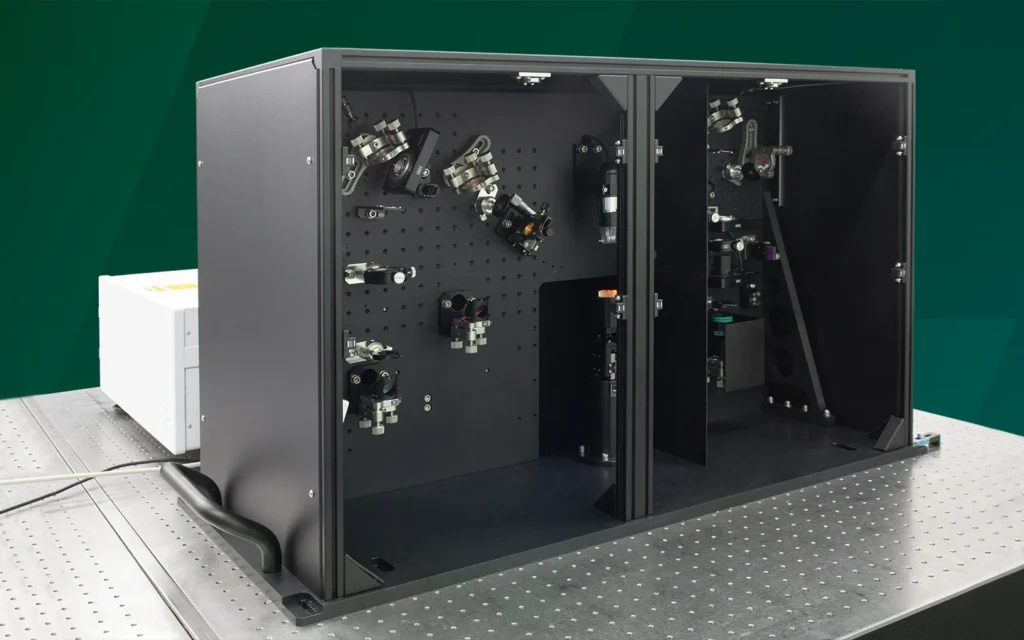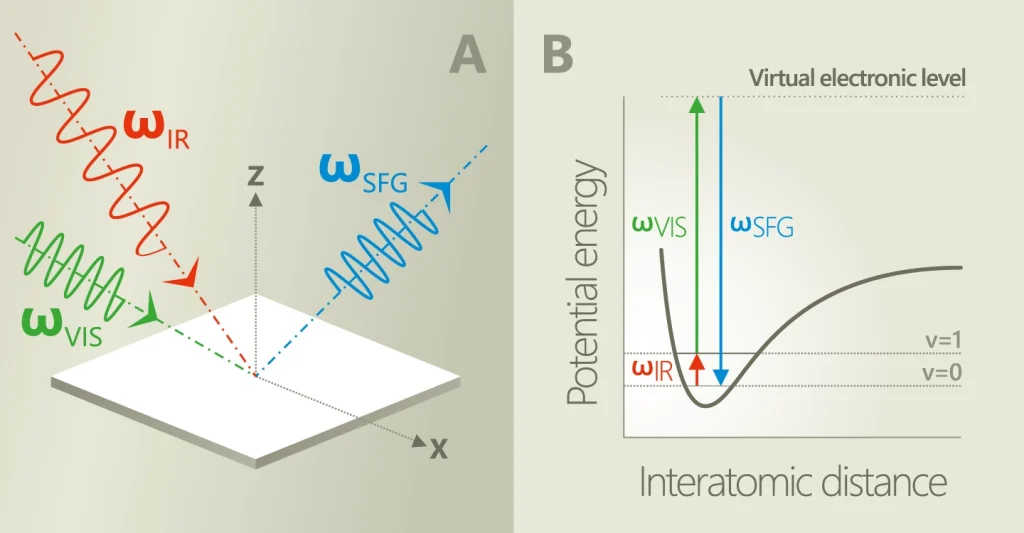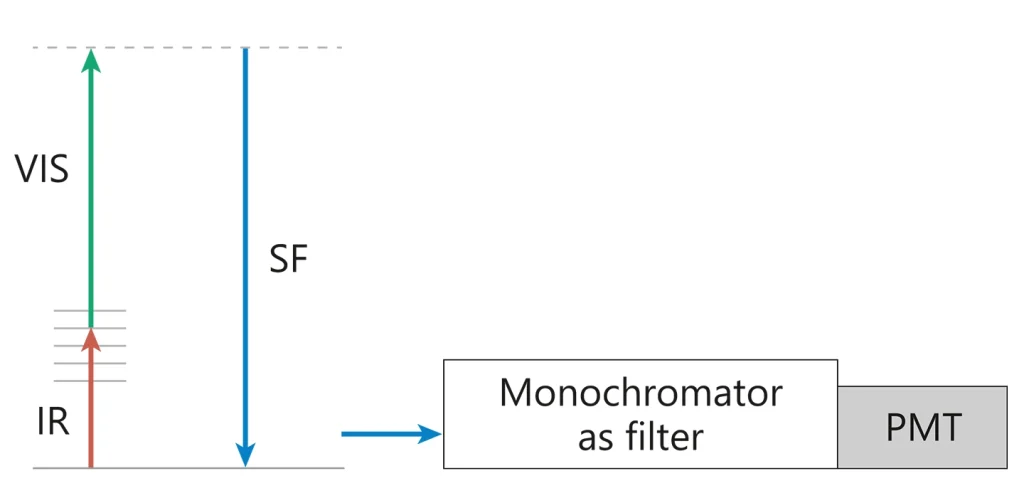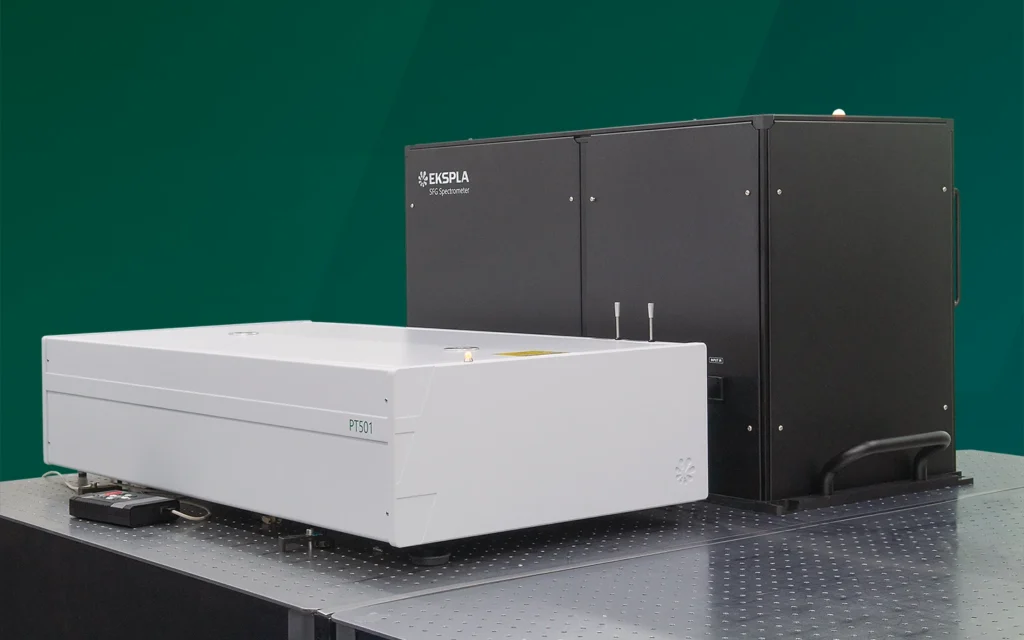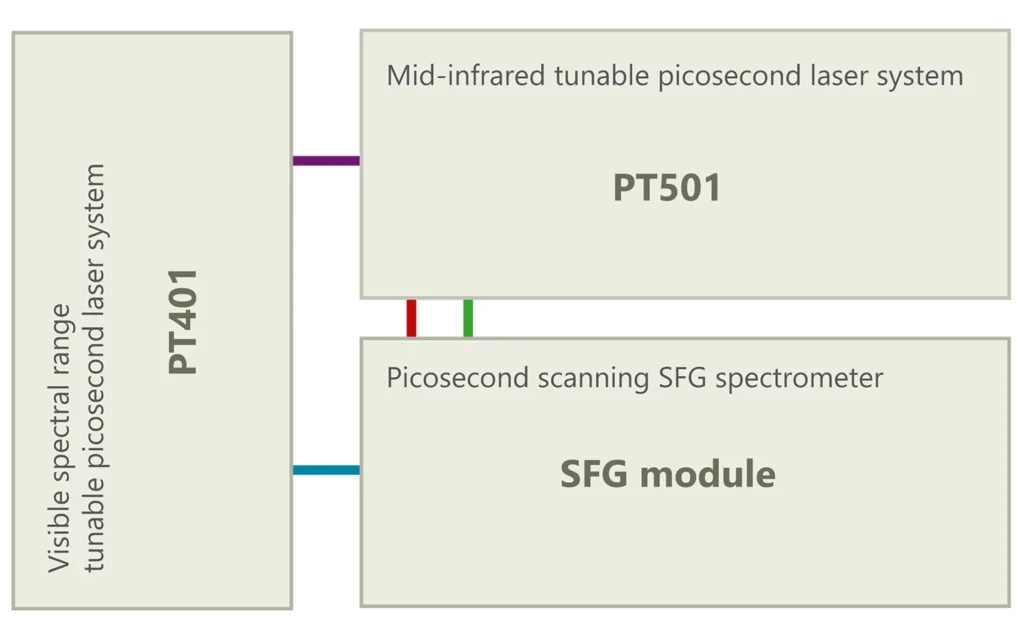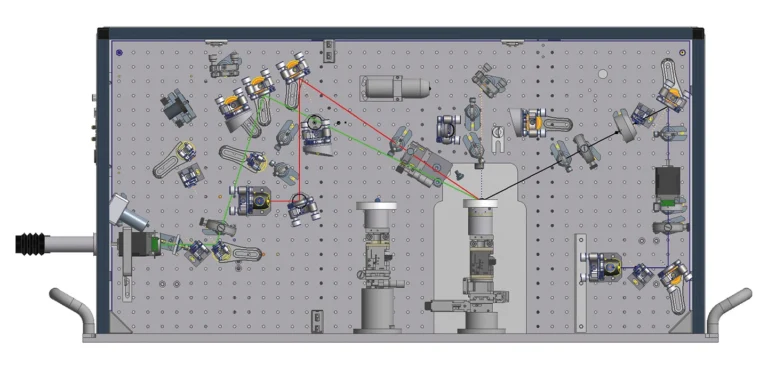Scanning SFG Spectrometer
Picosecond Scanning Sum Frequency Generation (SFG) Vibrational Spectrometer
In order to get SFG spectrum during measurement wavelength of narrowband mid-IR pulse is changed point-by-point throughout the range of interest. Narrowband SFG signal is recorded by the time-gated photomultiplier.
Advantages
- Sensitive and selective to the orientation of molecules in the surface layer
- Intrinsically surface specific
- Selective to adsorbed species
- Sensitive to submonolayer of molecules
- Applicable to all interfaces accessible to light
- Nondestructive
- Capable of high spectral and spatial resolution
Applications
- Investigation of surfaces and interfaces of solids, liquids, polymers, biological membranes and other systems
- Studies of surface structure, chemical composition and molecular orientation
- Remote sensing in hostile environment
- Investigation of surface reactions under real atmosphere, catalysis, surface dynamics
- Studies of epitaxial growth, electrochemistry, material and environmental problems
Sum Frequency Generation Vibrational Spectroscopy
Sum Frequency Generation Vibrational Spectroscopy (SFG-VS) is powerful and versatile method for in-situ investigation of surfaces and interfaces. In SFG-VS experiment a pulsed tunable infrared IR (ωIR) laser beam is mixed with a visible VIS (ωVIS) beam to produce an output at the sum frequency (ωSFG = ωIR + ωVIS). SFG is second order nonlinear process, which is allowed only in media without inversion symmetry. At surfaces or interfaces inversion symmetry is necessarily broken, that makes SFG highly surface specific. As the IR wavelength is scanned, active vibrational modes of molecules at the interface give a resonant contribution to SF signal. The resonant enhancement provides spectral information on surface characteristic vibrational transitions.
Vibrational sum frequency generation (SFG) spectroscopy offers several important advantages over traditional spectroscopy methods for the molecular level analysis of interfaces, including surface sensitivity, vibrational specificity, and the possibility to extract detailed information on the ordering and orientation of molecular groups at the interface by analysis of polarization-dependent SFG spectra.
Spectra examples
Comparison of Narrowband and Broadband SFG Spectrometers
Narrowband picosecond scanning SFG spectrometer
In order to get SFG spectrum during measurement wavelength of narrowband mid-IR pulse is changed point-by-point throughout the range of interest. Narrowband SFG signal is recorded by the time-gated photomultiplier. Energy of each mid-IR, VIS and SFG pulse is measured. After the measurement, the SFG spectrum can be normalised according to IR and VIS energy. Spectral resolution is determined by the bandwidth of the mid-IR light source. The narrower mid-IR pulse bandwidth, the better the SFG spectral resolution. Separate vibrational modes are excited during the measurement.
Broadband femtosecond SFG spectrometer
A broadband mid-IR pulse is mixed with a narrowband VIS pulse. The result is broadband SFG spectrum which is recorded using a monochromator and a sensitive CCD camera. The full spectrum is acquired simultaneously by integrating signal over time. Spectral resolution is determined by the bandwidth of the VIS pulse and on the monochromator-camera combination. The narrower the bandwidth of VIS pulse, the better the SFG spectral resolution.
Comparison of different SFG spectrometres
| Narrowband Picosecond Scanning Spectrometer | Broadband Femtosecond High Resolution Spectrometer |
|---|---|
| Narrowband mid-IR excitation, only one band is excited. Coupled states can be separated. | Simultaneous exsitation and recording of broad vibration spectrum with high resolution. |
| High mid-IR pulse energy. Less influence of IR absorbtion in the air. | High mid-IR intensity at low pulse energy – suitable for biological or other water containing samples. |
| No reference spectrum needed, IR energy measured at each spectral point. | Optically coupled IR and VIS channels. Reduced complexity and increased stability of the system. |
Spectra examples
Features and Design
System Components
- Picosecond mode-locked
- Nd:YAG laser and optical parametric generator in one unit
- Spectroscopy module with:
– PMT based signal detectors
– Data acquisition system
– Dedicated LabView® software package for system control - Fast wavelength scan (sweep)
The SFG spectrometer developed by Ekspla engineers is a nonlinear spectrometry instrument, convenient for everyday use. Ekspla manufactures SFG spectrometers, which are used by chemists, biologists, material scientists, and physicists. The spectrometer has many features that help to set up measurements and to make successful vibrational spectroscopy studies. For chemical and biochemical laboratories, this makes the Ekspla SFG spectrometer a reliable workhorse with a broad spectral region, automatically tuned from 625 to 4300 cm‑1, a high spectral resolution (3 cm‑1), and easily controlled adjustment of polarisation optics.
The new SFG classic spectrometer consist of two units: laser light source PT501 and spectroscopy module.
The Ekspla SFG system is based on a mode-locked Nd:YAG laser with a 29 ps pulse duration, 100 Hz repetition rate. The VIS channel of the SFG spectrometer consists of part of a laser output beam, usually with doubled frequency (532 nm) up to 0.3 mJ. The main part of the laser radiation goes to an optical parametric generator (OPG) with a difference frequency generation (DFG) extension. The IR channel of the spectrometer is pumped by the DFG output beam with energy in the range of ~40 – 200 μJ. Infrared light can be tuned in a very broad spectral range from 2.3 up to 16 μm. The bandwidth is 3 cm‑1 and it is one of the main factors of SFG spectrometer spectral resolution. The second beam (VIS) is also narrowband at <2 cm‑1. The spectrometer signal detection system has a temporal gate. It significantly reduces accumulative noise and ambient light influence, which allows to use spectrometer even in a brightly illuminated room. The spectrometer does not have any acoustic noise because the laser is pumped by light emiting laser diodes.
The spot size of the IR beam is adjustable. In this way, the appropriate energy density is achieved in order to avoid damaging or modifying the sample. Spectrum scanning, polarisation control and VIS beam attenuation are controlled from a computer. The spectrometer has a motorized polarisation switch for the IR, optionaly for the VIS, and optionaly the generated SFG light beams. Energy detectors continuously monitor the energy of the VIS and mid-IR laser pulses, so IR energy is recorded at each measurement point. This makes it possible to normalise the resulting SFG vibrational spectrum.
Fast wavelength scan (sweep) allows fast access to a wide spectral range. Using time-synchronised motor positions enables fast and smooth wavelength tuning which allows users to scan the full range in just a few seconds or access specific wavelengths within 0.3 seconds.
A large sample compartment can be customised and enables the use of various extensions and additional instruments for simultaneous control of the sample conditions, including a Langmuir-Blodgett trough for air/water and lipid/air interface studies, temperature and humidity-controlled cells, and other instruments.
The spectrometer is safe to use: all high energy pulsed beams are enclosed. In addition, the sample area also has a special cover. During the measurements, it is possible to close the sample compartment so that radiation cannot penetrate outside. The automatic change of polarisation and energy attenuation makes it possible to perform measurements without opening the spectrometer. Laser safety precautions are required only for the alignment of the laser beams on the studied surface.
Modification
- Double resonance SFG spectrometer – allows investigation of vibrational mode coupling to electron states at a surface
- Phase sensitive SFG spectrometer – allows measurement of the complex spectra of surface nonlinear response coefficients
Options
- Single or double wavelength VIS beam: 532 nm and/or 1064 nm
- One or two detection channels: main signal and reference
- Second harmonic generation surface spectroscopy option
- Motorized polarisation control for VIS and SFG beams
- Larger sample compartment to accomodate Langmuir through
- Simultaneous measurement of s and p polarisation of SFG signal
Both IR and VIS wavelengths are tunable in Double resonance SFG spectrometer model.
This two-dimensional spectroscopy is more selective than single resonant SFG. Double resonant SFG allows investigation of vibrational mode coupling to electron states at a surface.
Double resonance enables the use of another wavelength for VIS beam if the sample has strong absorption at 532 nm and 1064 nm. A range 420 – 680 nm is typically used for VIS beam.
The second tunable laser system is used for the double-resonance SFG. Two laser systems PT501 and PT401 are opticaly synchronised.
* Laser is located in the PT501 system. System PT401 can not operate separately from PT501.
A phase sensitive spectrometer allows the measurement the phase of nonlinear susceptibility χ(2). Reference and test samples are used and the SFG phase difference between them is scanned. The real and imaginary parts of second order susceptibility are calculated from the experimental results. Such an approach enables the unambiguous determination of the orientation of molecular groups at the interface.
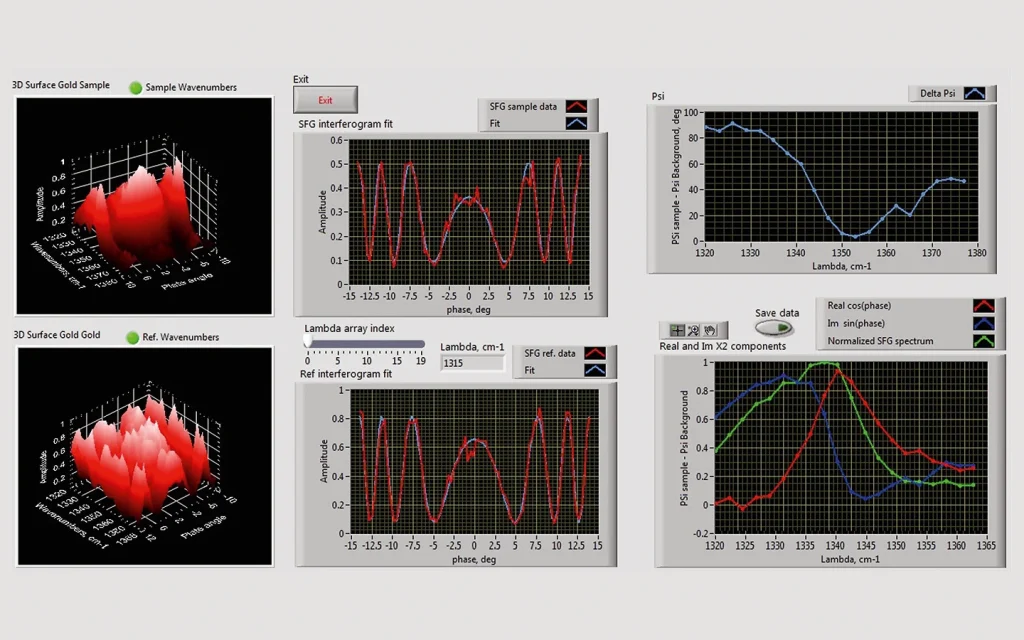
Phase-sensitive SFG spectrometer software.
Interferograms of AZO (azophenylcarbazole) dyes on the Au surface and fitted SF spectra with amplitude and phase distinguished.
In conventional SFG-VS intensity of SF signal is measured. It is proportional to the square of second order nonlinear susceptibility ISF ~ | χ(2) |2. However, χ(2) is complex, and for complete information, we need to know both the amplitude and the phase. This will allow us to determine the absolute direction in which the bonds are pointing and characterize their tilt angle with respect to the surface. Measurement of the phase of an optical wave requires an interference scheme. Mixing the wave of interest with a reference wave of known phase generates an interference pattern, from which the phase of the wave can be deduced.
In practice Phase-sensitive SFG experimental setup includes two samples generating SF signal simultaneously. One sample (usually called local oscillator) has well known and flat spectral response. Second one is investigated sample. The excitation beams are directed to first sample, where SFG beam is generated. Later all three beams are retranslated to the second sample, where another SFG beam is generated. Due to electromagnetic waves coherence both SFG beam are interfering. Setup contains the phase modular located on the SFG beam path between samples. We are able to change the phase of SFG beam by rotating it. This way we are recording two-dimensional interfererogram with wavelength and phase shift on x and y axis. Using fitting algorithms we are able to calculate the amplitude and phase of SF signal.
Interference measurements of SFG signals from reference sample and the investigated sample for Phase-sensitive configuration.
Switchable setup. Phase Sensitive / “Classic” Top configuration.
Switch: VIS beam manual. IR mirror mount is motorised, lens positioning stage is manual.
Path length to the sample is same in all configuration
Motorised polarisation control.
VIS beam 532 nm. IR 2.3 – up to 16 µm.
Options
- Spectrometer has “Classic” and “Phase-sensitive” properties:
- Easy switching between setups
- Adjustable spot size for classic configuration
Polarisation control
Simultaneous measurement of S and P polarisation
S and P polarisation of the SFG signal are detected during the same measurement in the dual polarisation detection system.
Motorized polarisation control of SFG, VIS, IR
The SFG spectrometer has a motorized polarisation switch for the IR, VIS, and the generated SFG light beams. The automatic change of polarisation and energy attenuation makes it possible to perform measurements without opening the spectrometer.
- Motorized switching of IR – standard
- Motorized control in small steps of SFG, VIS – optionally
SFG Spectrometer Accessories
- Six axis sample holder
- Sealed temperature controlled sample chamber
- Larger sample area – space for Langmuir trough
- Motorisation of polarisation control of VIS and IR beams, polarisation analyser for SFG signal
Specifications
| Version 1) | SFG Classic | SFG Double resonance | SFG Phase sensitive |
|---|---|---|---|
| System (general) | |||
| Spectral range | 625 – 4300 cm‑1 | 625 – 4300 cm‑1 (VIS 532 nm) 1000 – 4300 cm‑1 (VIS 420 – 680 nm) | 1000 – 4300 cm‑1 |
| Spectral resolution | < 3 cm‑1 | < 3 cm‑1 | < 3 cm‑1 |
| Spectra acquisition method | Scanning and fast wavelength sweep | Scanning and fast wavelength sweep | Scanning and fast wavelength sweep |
| Sample illumination geometry | Top side, reflection | Top side, reflection | Top side, reflection |
| Incidence beams geometry | Co-propagating, non-colinear | Co-propagating, non-colinear | Co-propagating, non-colinear |
| Incidence angles | Fixed, VIS ~60 °, IR ~55 ° (optional: tunable) | Fixed, VIS ~60 °, IR ~55 ° (optional: tunable) | Fixed, VIS ~60 °, IR ~55 ° |
| VIS beam wavelength | 532 nm | 532 nm and tunable 420 – 680 nm | 532 nm |
| Polarization (VIS, IR, SFG) | Linear, selectable “s” or “p”, purity > 1:100 | Linear, selectable “s” or “p”, purity > 1:100 | Linear, selectable “s” or “p”, purity > 1:100 |
| IR Beam spot on the sample | Adjustable, ~200 – 600 µm | Adjustable, ~200 – 600 µm | Fixed |
| Sensitivity | Air-water interface spectra | Air-water interface spectra | Solid sample spectra |
| Laser light source 2) | |||
| Model | PT501-SH | PT501-SH | PT501-SH |
| Pulse duration | 29 ± 5 ps | 29 ± 5 ps | 29 ± 5 ps |
| Pulse repetition rate | 100 Hz | 100 Hz | 100 Hz |
| UV-VIS source for Double resonance SFG | – | PT401 | – |
| Physical characteristics (footprint) | |||
| Standard | 1300 × 1200 mm | 1800 × 1200 mm | 1400 × 1200 mm |
| Version 1) | SFG Classic | SFG Double resonance | SFG Phase sensitive |
|---|
- Due to continuous improvement, all specifications are subject to change without advance notice.
- Laser is optimised for pumping parametrical generator, maximum output energy may be different than specified for stand alone application.
Publications
Hydrogen bonding interactions of H₂O and SiOH on a boroaluminosilicate glass corroded in aqueous solution
Hydrogen bonding interactions play an important role in many chemical and physical processes occurring in bulk liquids and at interfaces. In this study, hydrous species (H2O and Si-OH) on nano-porous alteration layers (gels) formed on a boroaluminosilicate glass called International Simple Glass corroded in aqueous solutions at pH 7 and pH 9, and initially saturated with soluble silicon-containing species were analyzed using linear and non-linear vibrational spectroscopy in combination with molecular dynamics simulations. The simulation results revealed various possible types of hydrogen bonds among these hydrous species in nanoconfinement environments with their populations depending on pore-size distribution. The nano-porous gels formed on corroded glass surfaces enhance hydrogen bond strength between hydrous species as revealed by attenuated total reflectance infrared spectroscopy. Sum frequency generation spectroscopy showed some significant differences in hydrogen bonding interactions on alteration layers formed at pH 7 and pH 9. The glass dissolution under the leaching conditions used in this study has been known to be ten times faster at pH 7 in comparison to that at pH 9 due to unknown reasons. The simulation and experimental results obtained in this study indicate that the water mobility in the gel formed at pH 9 could be slower than that in the gel formed at pH 7, and as a result, the leaching rate at pH 9 is slower than that at pH 7.
Structure Determination of Hen Egg-White Lysozyme Aggregates Adsorbed to Lipid/Water and Air/Water Interfaces
We use vibrational sum-frequency generation (VSFG) spectroscopy to study the structure of hen egg-white lysozyme (HEWL) aggregates adsorbed to DOPG/D2O and air/D2O interfaces. We find that aggregates with a parallel and antiparallel β-sheet structure together with smaller unordered aggregates and a denaturated protein are adsorbed to both interfaces. We demonstrate that to retrieve this information, fitting of the VSFG spectra is essential. The number of bands contributing to the VSFG spectrum might be misinterpreted, due to interference between peaks with opposite orientation and a nonresonant background. Our study identified hydrophobicity as the main driving force for adsorption to the air/D2O interface. Adsorption to the DOPG/D2O interface is also influenced by hydrophobic interaction; however, electrostatic interaction between the charged protein’s groups and the lipid’s headgroups has the most significant effect on the adsorption. We find that the intensity of the VSFG spectrum at the DOPG/D2O interface is strongly enhanced by varying the pH of the solution. We show that this change is not due to a change of lysozyme’s and its aggregates’ charge but due to dipole reorientation at the DOPG/D2O interface. This finding suggests that extra care must be taken when interpreting the VSFG spectrum of proteins adsorbed at the lipid/water interface.
Aggregation states of poly (4-methylpentene-1) at a solid interface
A thin film of poly(4-methylpentene-1) (P4MP1) was prepared on a quartz substrate, which was a model system of an interface in filler-reinforced semicrystalline polymer composites. Grazing-incidence wide-angle X-ray diffraction measurements revealed that P4MP1 in the thin film after isothermal crystallization formed a Form I crystal polymorph composed of a tetragonal unit cell with a 72 helix, in which the chain axis was oriented along the direction parallel to the quartz interface. Combining sum-frequency generation vibrational spectroscopy with molecular dynamics simulation enabled us to gain access to the local conformation of P4MP1 chains at the quartz interface and the changes that occurred with isothermal crystallization. Finally, the way in which the initial chain orientation at the substrate interface impacted the crystalline structure in the thin film was discussed.
Reconfiguration of interfacial energy band structure for high-performance inverted structure perovskite solar cells
Charged defects at the surface of the organic–inorganic perovskite active layer are detrimental to solar cells due to exacerbated charge carrier recombination. Here we show that charged surface defects can be benign after passivation and further exploited for reconfiguration of interfacial energy band structure. Based on the electrostatic interaction between oppositely charged ions, Lewis-acid-featured fullerene skeleton after iodide ionization (PCBB-3N-3I) not only efficiently passivates positively charged surface defects but also assembles on top of the perovskite active layer with preferred orientation. Consequently, PCBB-3N-3I with a strong molecular electric dipole forms a dipole interlayer to reconfigure interfacial energy band structure, leading to enhanced built-in potential and charge collection. As a result, inverted structure planar heterojunction perovskite solar cells exhibit the promising power conversion efficiency of 21.1% and robust ambient stability. This work opens up a new window to boost perovskite solar cells via rational exploitation of charged defects beyond passivation.
Segregation of an amine component in a model epoxy resin at a copper interface
We have studied the chemical composition of the epoxy and amine components, HDGEBA and CBMA, of an epoxy resin in close proximity to a copper interface by using ADXPS in conjunction with SFG vibrational spectroscopy. A bilayer sample of epoxy resin and copper was first prepared on a solid substrate before etching the copper layer just before the interface with Ar+ beams. Using ADXPS, in which an incident X-ray was guided from the copper surface, it was found that the CBMA component was preferentially segregated at the copper interface, with the segregation extending over ~10 nm. SFG spectroscopy was used to confirm the above observation. Postulating that copper ions diffused from the metal copper into the internal phase during the curing process and reacted with amine groups to form copper complexes, the interfacial segregation of CBMA can be understood. This knowledge should be useful for understanding and controlling the adhesive properties of epoxy resins.
Vibrational Relaxation Lifetime of a Physisorbed Molecule at a Metal Surface
Previous measurements of vibrational relaxation lifetimes for molecules adsorbed at metal surfaces yielded values of 1–3 ps; however, only chemisorbed molecules have been studied. We report the first measurements of the vibrational relaxation lifetime of a molecule physisorbed to a metal surface. For CO(υ=1) adsorbed on Au(111) at 35 K the vibrational lifetime of the excited stretching mode is 49±3 ps. The long lifetime seen here is likely to be a general feature of physisorption, which involves weaker electronic coupling between the adsorbate and the solid due to bonding at larger distances.
Heavy Anionic Complex Creates a Unique Water Structure at a Soft Charged Interface
Ion hydration and interfacial water play crucial roles in numerous phenomena ranging from biological to industrial systems. Although biologically relevant (and mostly smaller) ions have been studied extensively in this context, very little experimental data exist about molecular-scale behavior of heavy ions and their complexes at interfaces, especially under technologically significant conditions. It has recently been shown that PtCl62– complexes adsorb at positively charged interfaces in a two-step process that cannot fit into well-known empirical trends, such as Hofmeister series. Here, a combined vibrational sum frequency generation and molecular dynamics study reveals that a unique interfacial water structure is connected to this peculiar adsorption behavior. A novel subensemble analysis of molecular dynamics simulation results shows that after adsorption PtCl62– complexes partially retain their first and second hydration spheres and that it is possible to identify three different types of water molecules around them on the basis of their orientational structures and hydrogen-bonding strengths. These results have important implications for relating interfacial water structure and hydration enthalpy to the general understanding of specific ion effects. This in turn influences interpretation of heavy metal ion distribution across, and reactivity within, liquid interfaces.
High-performance graphdiyne-based electrochemical actuators
Electrochemical actuators directly converting electrical energy to mechanical energy are critically important for artificial intelligence. However, their energy transduction efficiency is always lower than 1.0% because electrode materials lack active units in microstructure, and their assembly systems can hardly express the intrinsic properties. Here, we report a molecular-scale active graphdiyne-based electrochemical actuator with a high electro-mechanical transduction efficiency of up to 6.03%, exceeding that of the best-known piezoelectric ceramic, shape memory alloy and electroactive polymer reported before, and its energy density (11.5 kJ m−3) is comparable to that of mammalian skeletal muscle (~8 kJ m−3). Meanwhile, the actuator remains responsive at frequencies from 0.1 to 30 Hz with excellent cycling stability over 100,000 cycles. Furthermore, we verify the alkene–alkyne complex transition effect responsible for the high performance through in situ sum frequency generation spectroscopy. This discovery sheds light on our understanding of actuation mechanisms and will accelerate development of smart actuators.
Vibrational fingerprint of localized excitons in a two-dimensional metal-organic crystal
Long-lived excitons formed upon visible light absorption play an essential role in photovoltaics, photocatalysis, and even in high-density information storage. Here, we describe a self-assembled two-dimensional metal-organic crystal, composed of graphene-supported macrocycles, each hosting a single FeN4 center, where a single carbon monoxide molecule can adsorb. In this heme-like biomimetic model system, excitons are generated by visible laser light upon a spin transition associated with the layer 2D crystallinity, and are simultaneously detected via the carbon monoxide ligand stretching mode at room temperature and near-ambient pressure. The proposed mechanism is supported by the results of infrared and time-resolved pump-probe spectroscopies, and by ab initio theoretical methods, opening a path towards the handling of exciton dynamics on 2D biomimetic crystals.
A structural and temporal study of the surfactants behenyltrimethylammonium methosulfate and behenyltrimethylammonium chloride adsorbed at air/water and air/glass interfaces using sum frequency generation spectroscopy
Molecular scale information about the structure of surfactants at interfaces underlies their application in consumer products. In this study the non-linear optical technique of Sum Frequency Generation (SFG) vibrational spectroscopy has been used to investigate the structure and temporal behaviour of two cationic surfactants used frequently in hair conditioners. SFG spectra of films of behenyltrimethylammonium methosulfate (BTMS) and behenyltrimethylammonium chloride (BTAC) were recorded at the air/water interface and on glass slides following Langmuir Blodgett (LB) deposition. The assignment of the BTMS and BTAC spectral features (resonances) to the C—H stretching modes of the surfactants was consolidated by comparison with the SFG spectrum of deuterated cetyltrimethylammonium bromide (d-CTAB) and by recording spectra on D2O as well as on water. The C—H resonances arise from the methylene and methyl groups of the tail and head-groups of the surfactants. A slow collapse mechanism was observed following film compression of both BTAC and BTMS. The change in molecular structure of the films undergoing this slow collapse was followed by recording sequential SFG spectra in the C—H region, and by monitoring the SFG intensity at specific wavenumbers over time. Additionally, LB deposition onto glass was used to capture the state of the film during the slow collapse, and these SFG spectra showed close similarity to the corresponding spectra on water. Complementary Atomic Force Microscopy (AFM) was used to elucidate the layering of the compressed and relaxed films deposited onto mica by LB deposition.
